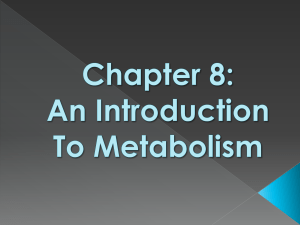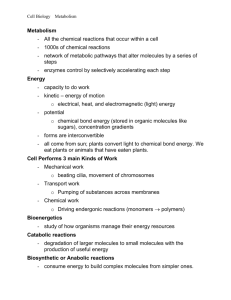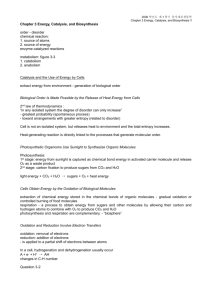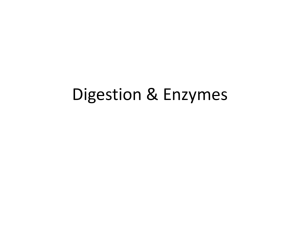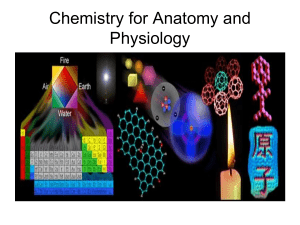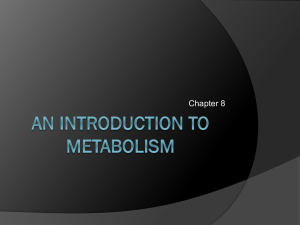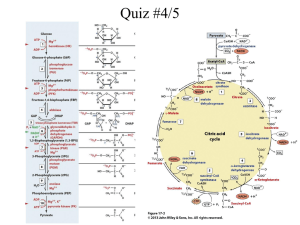Energy, Catalysis, and Biosynthesis
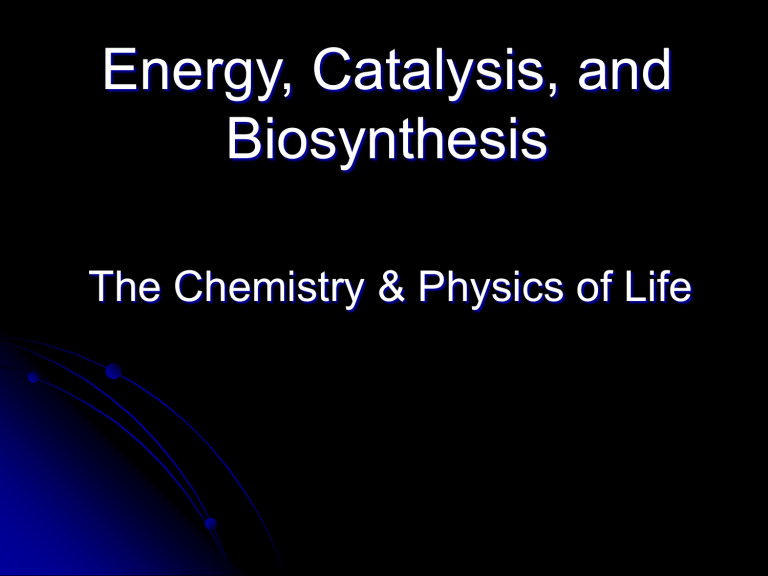
Energy, Catalysis, and
Biosynthesis
The Chemistry & Physics of Life
Laws of Thermodynamics
1 st Law
The total amount of energy in any process stays constant OR energy in the universe stays constant
2 nd Law
Although the total energy in the universe doesn’t change, less and less is available for work
What is Work?
Moving an object against a force
4 types
Mechanical – moving against a force
Chemical – creating chemical bonds
Concentration – changing concentration from one area to another
Electrical – changing the separation of charges
1
st
Law of
Thermodynamics
Energy can be converted from one form to another but cannot be created or destroyed
Universal Tendency – More Disorder
2 nd Law of Thermodynamics – degree of disorder increases
Movement towards disorder is a spontaneous process
Measure of disorder is entropy, greater disorder = greater entropy
Energy can be transformed from one form to another
FREE ENERGY
(available for work) vs.
HEAT
(not available for work)
Thermodynamics of Cells
Part of the energy that cells use is converted to heat and is released into the area around the cell
While inside the cell becomes more ordered, the heat put into the area around the cell causes more disorder – disorder is greater outside the cell than the order inside the cell
CHEMICAL REACTIONS AND ENERGY TRANSFERS
ARE CONTROLLED IN LIVING SYSTEMS
Enzymes - mediate chemical reactions
Energy transfers are done in steps
Example: There are two ways to get from the top of a very tall building to the bottom floor. Keep in mind that a person on the top floor of a building has a lot of potential energy relative to the ground level.
Jump out the window!
Take the stairs and expend the potential energy a little at a time until you get to the bottom floor.
Both methods get you to the bottom floor but one method is destructive, while the other is not. These two situations are analogous to uncontrolled vs. controlled energy transfers.
Potential energy transferred gradually so more work is done than heat.
Hydrogen gas + oxygen + activation energy water and explosion of heat, light and sound! (see http://www.youtube.com/watch?v=iwBYhJ2jHWw )
Hydrogen is broken; electrons and protons released; electron transport system extracts some free energy from electrons in a stepwise manner (redox reactions) + heat; low energy electron combines with oxygen and hydrogen to produce water process is non-destructive to life & some energy used to do work!
Regulation of energy-releasing (cellular respiration) and energy-acquiring chemical reactions in biological systems
•Chemically-mediated by enzymes and co-factors
•Occur in a step-wise manner
2H
2
+ O
2
2H
2
O + energy
+
+
2H-H + O=O
2H
2
O + energy
Modes of Energy Transformation: Rapid &
Uncontrolled
2H
2
+ O
2
2H
2
O + energy
Release of energy can be uncontrolled and liberated mostly as heat!
On May 6th, 1937 in Lakehurst,
New Jersey. The German passenger Zeppelin Airship called the Hindenburg , was attempting a mooring when it exploded.
Modes of Energy Transformation: Released in controlled steps or stages
2H
2
+ O
2
2H
2
O + energy
Released in steps to salvage free energy and minimize heat production
The electrons from the hydrogen bond go through a series of oxidation & reduction reactions. During each step some energy is harvested, while the remainder is released as heat.
Chemical Reactions
Occur in the cell under the control of specialized proteins called enzymes
Each one accelerates or catalyzes just one of the many reactions of the cells
Enzymes
Metabolic pathways
• series of enzyme-controlled reactions leading to formation of a product
• each new substrate is the product of the previous reaction
Enzyme names commonly
• reflect the substrate
• have the suffix – ase
• sucrase, lactase, protease, lipase
Tyrosinase and Melanin
Grey
Squirrels:
Melanic and
Albino Forms tyrosinase - A copper-containing enzyme of plant and animal tissues that catalyzes the production of melanin and other pigments from tyrosine by oxidation, as in the blackening of a peeled or sliced potato exposed to air.
Factors that influence enzymatic activity
Cofactors
• make some enzymes active
• ions or coenzymes
Factors that alter enzymes
• temperature and heat
• radiation
• electricity
• chemicals
• changes in pH
Coenzymes
• organic molecules that act as cofactors
• vitamins
Factors that influence enzymatic activity
Competitive inhibitor - a substance that binds to the active site of the enzyme and compete with the substrate for this place.
Non-competitive or allosteric inhibitor - a substance that binds to another part of the enzyme and cause an allosteric change in the overall shape of the enzyme; this changes the form of the active site so the substrate can't bind to it.
Allosteric Activators - essentially this is the reverse of an allosteric inhibitor.
Temperature Sensitive Tyrosinase –
Siamese Cats & Himalayan Rabbits
Cells Chemical
Pathways All
Interconnect
PHOTOSYNTHESIS & CHEMOSYNTHESIS
Almost all plants are photosynthetic autotrophs, as are some bacteria and protists
Autotrophs generate their own organic matter through photosynthesis or chemosynthesis
Sunlight energy is transformed into the energy stored in the form of chemical bonds
Chemical energy is transformed into the energy stored in the form of chemical bonds
(a) Mosses, ferns, and flowering plants
(b) Kelp
(c) Euglena
(d) Cyanobacteria
Bacteria in Thermal Vents on the Sea Floor
Tubeworms and other animals living around thermal vents in the ocean depend on chemosynthetic bacteria for food.
THE SUN: MAIN SOURCE OF
ENERGY FOR LIFE ON EARTH
Light Energy Harvested by Plants &
Other Photosynthetic Autotrophs
6 CO
2
+ 6 H
2
O + light energy → C
6
H
12
O
6
O
2
+ 6
Sunlight – Ultimate Energy Source
All organisms live on the organic molecules that are made by photosynthetic organisms
Photosynthesis traps the energy of the sun in the chemical bonds of sugars which can be turned into nucleotides, amino acids and fatty acids
2 steps
Energy stored in ATP and NADPH, release O
2
ATP and NADPH drive carbon fixation
H
2 air and make sugars
O and CO
2 from
Food Chain
THE FOOD WEB
Metabolism
2 opposing pathways make up metabolism
Catabolism – process of obtaining energy and building blocks from
‘food’ molecules
Anabolism – process of using energy and building blocks to create the macromolecules that make up the cell
Energy Releasing Metabolic Reactions
Energy
• ability to do work or change something
• heat, light, sound, electricity, mechanical energy, chemical energy
• changed from one form to another
• involved in all metabolic reactions
Release of chemical energy
• most metabolic processes depend on chemical energy
• oxidation of glucose generates chemical energy
• cellular respiration releases chemical energy from molecules and makes it available for cellular use
Oxidation of Organic Molecules
Oxidation can be the process of adding O atoms
Cells can obtain energy from sugars by allowing the C and
H to combine with O
2 to produce H process called respiration
2
O and CO
2 in a
Photosynthesis and respiration work together
Oxidation and Reduction
Oxidation can also be the process of electron transfer from one atom to another
Oxidation is the removal of electrons
Reduction is the addition of the electrons
Oxidation and reduction always occur simultaneously
These reactions also occur in molecules with a partial shift of electrons as in polar bonds
Also with the addition of a H + (hydrogenation reaction) or the removal of a H + (dehydrogenation reaction)
Reducing and Oxidizing Agents
Reducing agent
(electron donor)
A e -
B
Oxidizing agent
(electron acceptor) e -
A is oxidized – loses electron
B is reduced – gains electron
A
Oxidized e e -
B
Reduced
Tip to Help Remember
o s e
LEO
the lion goes
GER z e d i d i x n s r o c t l e i a n n s r o c t l e u c e d e d
Free Energy
Free Energy (G)
Energy that can be harvested to do work or drive a chemical reaction
(remember the 4 types of work)
Exergonic reactions – go from higher to lower energy level and are spontaneous
Endergonic reactions – go from lower to higher energy levels and require an input of energy
Reactions
Barriers to Chemical Reactions
Chemical reactions only proceed in the direction of the loss of free energy
Molecules in stable states need to have an input of energy to cause them to go to a lower energy state
– activation energy , always positive
Activation Energy
Activation Energy
In chemistry, molecules that decrease activation energy are catalyst such as platinum and zinc
In cells the activation energy is reduced by a special protein enzyme
Enzymes link 1 or 2 molecules called substrates and hold them in a way that greatly decreases the activation energy
– transition state
Transition States
Energy Graph
Enzymes as Catalysts
Speed up reaction rates (x ~10 14 )
Selective – usually 1 enzyme for 1 reaction
Have a unique shape that contains the active site and only a particular substrate can fit
site where reaction takes place
Remain unchanged and can be used over and over
Reactions
For reactions to occur, the enzyme and the substrate(s) need to be in contact with one another
Heat from other reactions keep the substrate moving through the cell by diffusion, can cover great distances
Enzyme is large and relatively motionless
This arrangement allows for the substrate to finally collide with the active site, held there by multiple weak interactions until they dissociate
If too strong, then would not dissociate
If wrong substrate gets into the active site, no interactions will hold it there and it will leave quickly
Enzymatic Reactions are Coupled
Even though enzymes are good catalysts, they are unable to perform reactions that are thermodynamically unfavorable
Enzyme reactions are coupled to harvest the energy and heat from a favorable reaction to drive an unfavorable reaction
Coupled Reactions
G – Change in Free Energy
Value of G is only important when the system undergoes a change
G is the measure of the amount of disorder when a reaction takes place
-
G occur spontaneously
+
G are unfavorable
Need to link a -
G reaction with a +
G so that the overall
G is negative
Coupled Reactions
Concentration of Reactants
The amount of reactants in the reaction mix is important for the
G
In a reversible reaction, i.e., can go from A to B and from B to A, when there is more A present, the tendency will be to go from A to B rather than B to A
G ° or standard free-energy change – depends on intrinsic characters of the reacting molecules
Equilibrium – forward and reverse reactions proceed at exactly equals rates so that no net chemical change occurs
Equilibrium
Equilibrium constant (K) – number that characterizes the equilibrium state for a reversible chemical reaction; given by the ratio of the forward and reverse rate constants of the reaction
Enzymes and K
Enzymes will lower the activation energy in the A to B direction to the same degree as in the B to A direction
The equilibrium constant and
G ° remain unchanged
Sequential Reactions
Most of the
G ° values are known for the reactions of the cells and so we can determine overall
G for a pathway – add up the
G for each step
Activated Carriers
Energy released by catabolism is stored in the chemical bonds of carrier molecules
The energy can be moved around the cell to where it is needed
Carrier molecules in the cell are ATP, NADH and NADPH
Activated Carriers in Metabolism
Activated Carrier
ATP
Group Carried in
High-Energy
Linkage phosphate
NADH, NADPH, FADH
2
Acetyl CoA
Carboxylated biotin
S -Adenosylmethionine
Uridine diphosphate glucose electrons and hydrogens acetyl group carboxyl group methyl group glucose
Coupled Reactions
Enzyme catalyzed reactions capture the energy released from the oxidation of glucose in a chemically useful form rather than as heat
ATP
ATP – adenosine triphosphate – is the most important and abundant activated carrier in the cell
Synthesized by adding a phosphate group to
ADP (adenosine diphosphate) in an energy unfavorable reaction
ATP can release the energy when it is needed by hydrolysis
Phosphate Transfer
Process of transferring a phosphate group to another molecule is the phosphorylation reaction
Enzyme that performs this reaction is a kinase
ATP Functions in
Condensation Reactions
Transfer of a Carboxyl Group
Synthesis of Polymers
Condensation reactions are unfavorable, require energy input
Hydrolysis reactions are favorable, can occur spontaneously
Polysaccharides
Proteins
Nucleic
Acids
Nucleic Acid Synthesis
NADH and NADPH
NADH and NADPH are activated carriers that carry energy and H +
NAD + - nicotinamide adenine dinucleotide
NADP + - nicotinamide adenine dinucleotide phophate
Both can pick up a H + and become reduced, carries 2 e and H +
NADPH
The phosphate group at the end of the molecule causes the molecule to have a different shape and therefore can interact with different enzymes than NADH
Purpose of NADPH and NADH
NADPH operates with enzymes that catalyze anabolic reactions – synthesis reactions
NADH usually works in catabolic reactions that generate ATP through the breakdown of food particles




